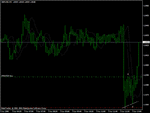I wonder why people underestimated rcar1046 question. That is the main problem with Joe Ross technique and exactly this problem should be addressed before using RH and TTE profitably. All this blah-blah about failed patterns and that they happen everywhere and no signal is perfect is going nowhere.
What we have here is clearly would-be-unprofitable pattern in case we trade multiple contracts and intend to close some part of them very soon after the TTE-entry.
I will try to address the problem. But, hopefully, Joe Ross can do it much better, although it seems so obvious to him and that is exactly why he doesn't go into it.
I see several ways to avoid rare big losses that turn a profitable pattern into a looser.
1) Put initial catastrophic stop very closely to the entry point. Or keep the catastrophic stop under the bottom of #3 (if long) but mentally be prepared to exit if the price doesn't go immediately in our direction. The idea is - we either have a big enough upside momentum or not. Although market needs to breath and we don't put S/L on breakeven straight away. We just need to watch the price closely (may be even every tick). As for Joe Ross, in one place he says that the initial S/L should be placed under #3 but moved higher as soon as possible, in another he says what I just said about big momentum. But it is still ambiguous. What if we are opening on a 4 hour chart? Watching every tick is ridiculous - it is too small-scaled. Price momentum on a 4 hours chart is not a movement tick-by-tick. On the other hand, if we are dealing with 10-30 min charts than potential bottom of #3 is never too far from entry, so the risk is not too big anyway.
For instance, would-be-#3 bar is 10 pips in length (in Forex 30 min chart). We open and set small target + 5 pips and S/L -10 pips. If we are trading in 2 lots, intending to close the first one on the small target, than in 40% we are stopped on -10, in 60% we hit +5. When we are stopped 4 times (out of 10) we loose -20x4 = -80 pips (on both lots), when we achieve target we get +5 x 6 = +30. We expect the second lot to be stopped at breakeven and sometime run into some bigger profits, therefore 50 pips loss can be covered (hopefully). If we increase number of lots and expect to dump more on the first target than fortune will turn even more in our favor....
But it is still a little bit shaky, as you can see.
To be continued…
What we have here is clearly would-be-unprofitable pattern in case we trade multiple contracts and intend to close some part of them very soon after the TTE-entry.
I will try to address the problem. But, hopefully, Joe Ross can do it much better, although it seems so obvious to him and that is exactly why he doesn't go into it.
I see several ways to avoid rare big losses that turn a profitable pattern into a looser.
1) Put initial catastrophic stop very closely to the entry point. Or keep the catastrophic stop under the bottom of #3 (if long) but mentally be prepared to exit if the price doesn't go immediately in our direction. The idea is - we either have a big enough upside momentum or not. Although market needs to breath and we don't put S/L on breakeven straight away. We just need to watch the price closely (may be even every tick). As for Joe Ross, in one place he says that the initial S/L should be placed under #3 but moved higher as soon as possible, in another he says what I just said about big momentum. But it is still ambiguous. What if we are opening on a 4 hour chart? Watching every tick is ridiculous - it is too small-scaled. Price momentum on a 4 hours chart is not a movement tick-by-tick. On the other hand, if we are dealing with 10-30 min charts than potential bottom of #3 is never too far from entry, so the risk is not too big anyway.
For instance, would-be-#3 bar is 10 pips in length (in Forex 30 min chart). We open and set small target + 5 pips and S/L -10 pips. If we are trading in 2 lots, intending to close the first one on the small target, than in 40% we are stopped on -10, in 60% we hit +5. When we are stopped 4 times (out of 10) we loose -20x4 = -80 pips (on both lots), when we achieve target we get +5 x 6 = +30. We expect the second lot to be stopped at breakeven and sometime run into some bigger profits, therefore 50 pips loss can be covered (hopefully). If we increase number of lots and expect to dump more on the first target than fortune will turn even more in our favor....
But it is still a little bit shaky, as you can see.
To be continued…


